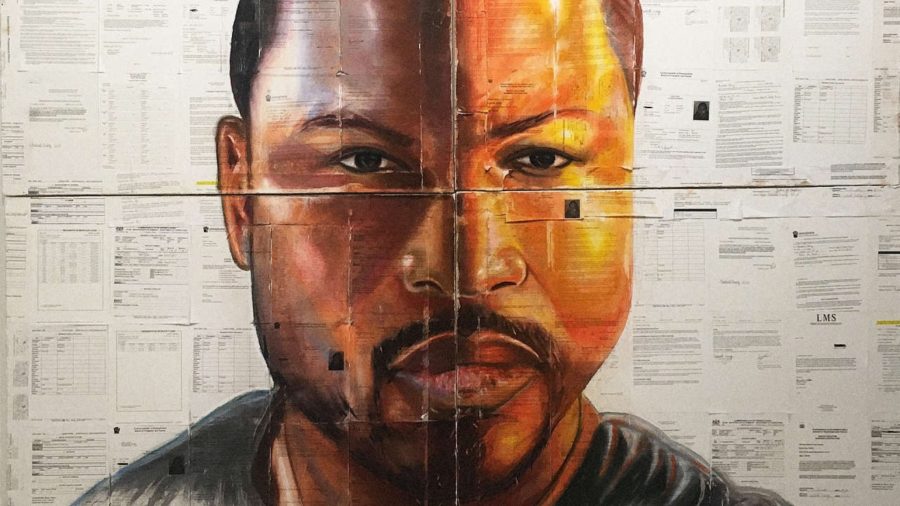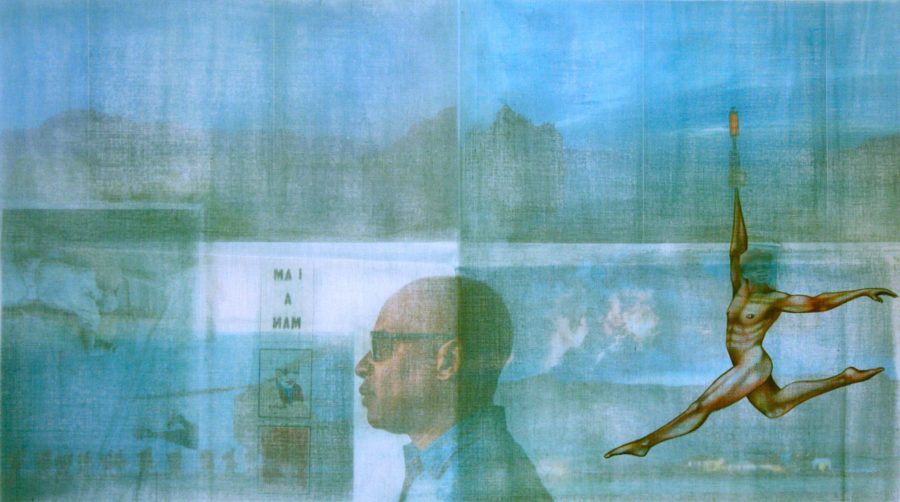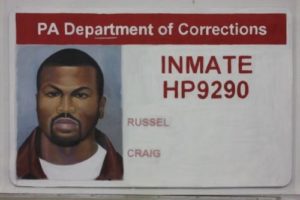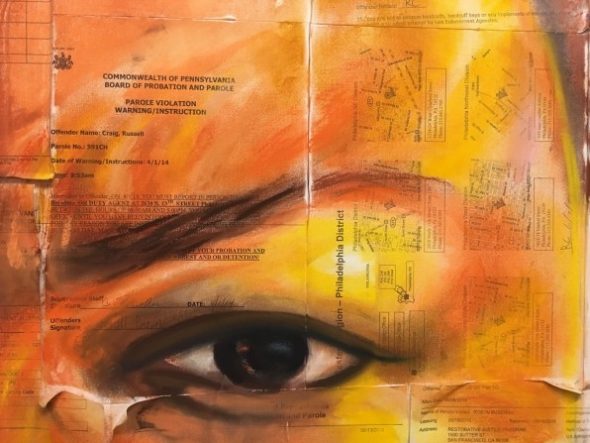Philadelphia artist Russell Craig was going through his prison paperwork in a halfway house when inspiration struck. ‘‘Basically, I had taken all my court documents and I was planning to throw them away,” Craig recalls. “I was just cleaning up. But I decided instead to do something creative with the papers. And that’s how the idea started, to do a portrait on them.”
The final product of this vision appeared in Truth to Power, a star-studded pop-up art exhibition in Philadelphia last July aimed at mobilizing the youth vote. Craig’s 8X8 self-portrait accompanied work by over 105 other artists, including Banksy. Craig had glued his prison paperwork to four canvases, then painted his face over them with pastel.

Self-portrait by Russell Craig, courtesy of Soze.
“I did a smaller version first but I made this one big because I wanted impact, so that a lot of people would see it even without walking up on it. You don’t know it’s prison papers until you get close.” Through his connection to another formerly incarcerated artist, Jesse Krimes, Craig was invited to participate in the show, an experience he calls “surprising and life-changing.”
Krimes and Craig are inaugural fellows for a new program called Right of Return. This opportunity, administered by the Soze Ad Agency and funded by Open Philanthropy, will award five formerly incarcerated artists $20,000 each (half as a prize, and half for materials and production) to support the completion of a project that addresses mass incarceration. Right of Return is using Submittable to accept applications and, ultimately, select the three fellows who will join Krimes and Craig in the program’s first year.

‘Gucci Mane’ by Jesse Krimes, courtesy of Soze.
Craig was was released in 2013 after a drug-related seven-year sentence, having served a total of five years before that for shorter-term bids. He credits art with turning his life around; he met his mentor James Huff while they were both incarcerated. Huff has served 25 years and was sentenced as a juvenile. “He inspired me to take art seriously,” Craig remembers. “He was at a really high level, he did a lot of studies, and he helped me believe I could really do something with my work.”
Both men are skilled in portraiture. Craig’s development of this art served as an unsanctioned source of revenue inside. It was a business but it also helped him focus. “People would hire me to paint their girlfriend, or daughter, or mother, or whoever – and then they would send it to their family as a gift.”

Russell Craig as a tour guide at Eastern State Penitentiary, discussing his art. Image source here.
Craig’s art displays his realistic precision as well as his larger conceptual intentions. In discussing his Truth to Power piece, Craig recall’s Public Enemy. “I wanted to place myself within the four different canvases so the separation would be like crosshairs. Like being targeted. I wanted to play off Public Enemy, Chuck D, and Flava Flav, without being too direct.”
Another self-portrait Craig completed in the halfway house underscores the significance of the messages his art contains. Done with acrylic on cloth, the painting is a blown-up version of Craig’s prison ID card. In the top portion of the painting, under the words “PA Department of Corrections,” he has underlined the “art” in “department.”

Russell Craig’s Prison ID Painting. Image source here.
“I used art to change my whole life. I used it to get out of prison life, to get out of street life, that whole other life that I led. Deciding to underline the word ‘art’ is confirming that. It is backing that idea up.” Because Craig was working with Mural Arts Philadelphia during his halfway house stay, he was given clearance to have and use art materials that otherwise would have been contraband.
With the exception of Craig’s face, the largest portion of this painting is his inmate ID number, HP9290. “When you go to prison, you become that number. My identity, who I was, didn’t matter. You become like an item. Like property. I wanted to bring that to people’s attention.”
Although Craig is very careful not to talk about his latest ideas until they are completed (he describes creative inspiration as a sudden and strong voice from his conscience), he will share his anticipation for the fellowship and for establishing his artistic career. “Right now, I have to take commission work to stay afloat but I want to really be able to focus. I think I’m moving in that direction, to be exploring and executing a lot of my own stuff, to have a great body of work.”
The fellowship money will provide him this opportunity, as well as access to quality materials. “If there’s anything I don’t have I’ll be able to get it, without a problem. It’s like nothing will hold me back.” Still, Craig hasn’t allowed any lack of expensive supplies to inhibit him. One recent project was painted on internet printouts. The printed articles focused on a law involving employer rights and dreadlocks. Craig collected human hair from a barber shop to attach to a portrait he made of a woman with dreads.
The constraint of limited supplies experienced by incarcerated artists can serve, according to Craig, as a stimulus. “It forces you to be creative when you’re in those circumstances where you have less, when you’re in prison and you have nothing. If you have that in you, that little seed of creativity, it grows.”
After a sentence is completed, formerly incarcerated individuals often struggle to reintegrate themselves into society and find employment. “When you’ve got a felony, it’s hard to get back to real life. It stays on you. It takes a certain kind of person to keep making art on the outside and then to make a living off it. That’s why the fellowship is extremely important.”

Self portrait close-up. Image sourced here.
The Right of Return Fellowship deadline is Friday, April 21. The application form is very straightforward: only contact information and two references are required, although applicants are encouraged to include a written or video statement and work sample(s).
Craig is looking forward to interacting with the selected artists. “The fellowship is an amazing opportunity for people who haven’t been discovered yet. I can’t wait to see these things that people are submitting. I can’t wait to see the talent. I don’t get excited about a lot of things lately, because all this crazy stuff is happening in the world but I’m looking forward to seeing who steps forward. This fellowship is providing that stage and that opportunity.”
